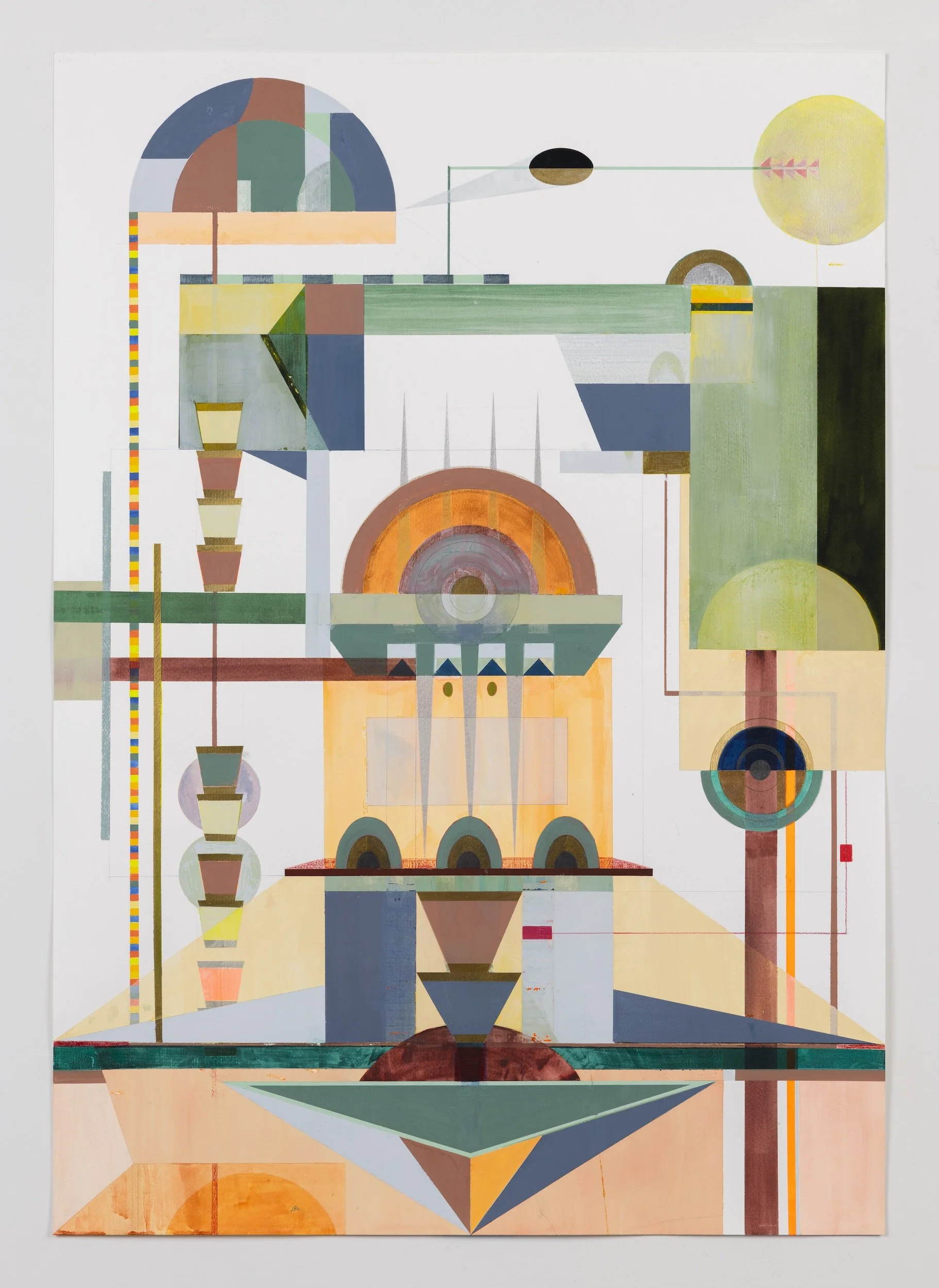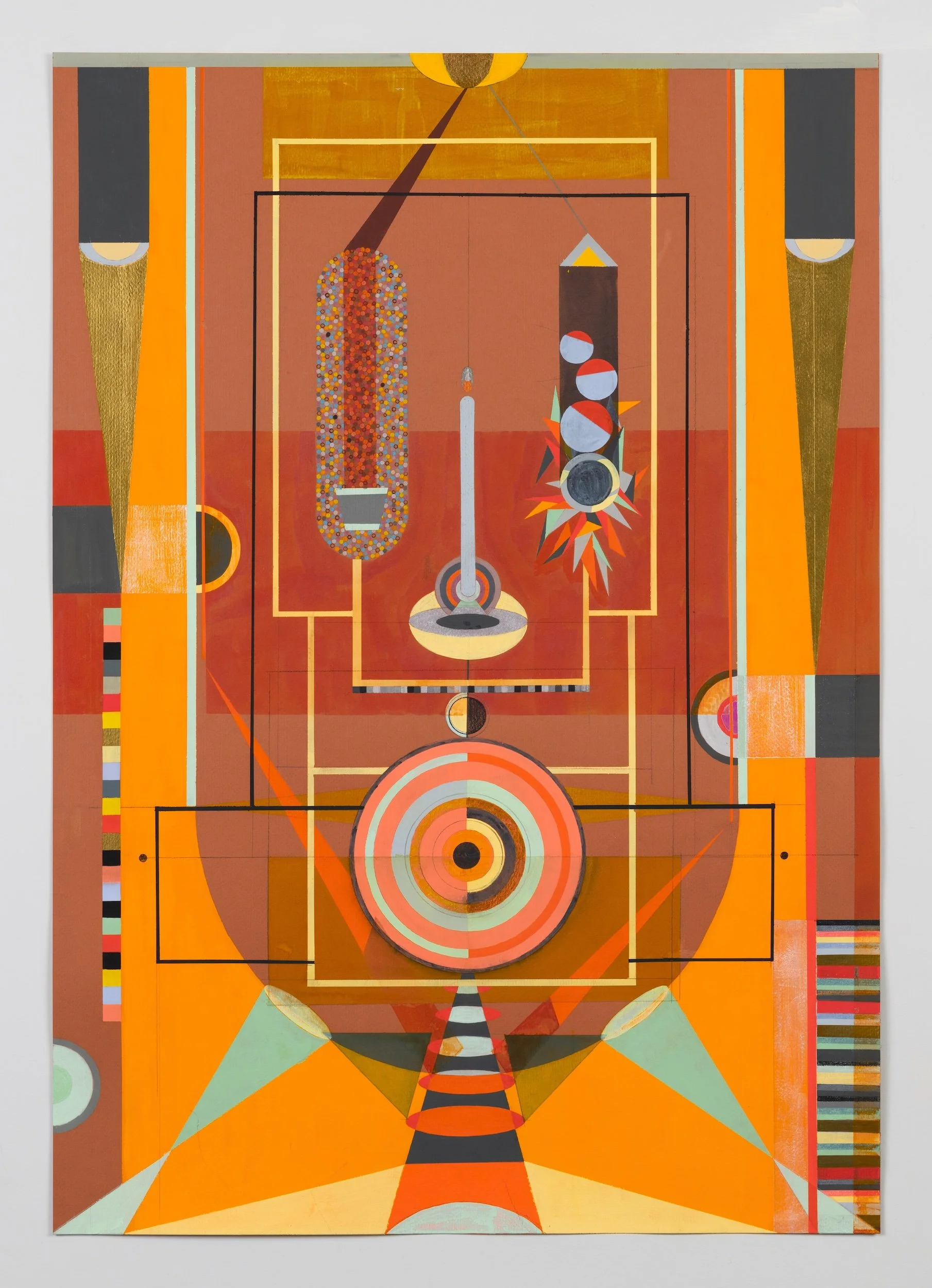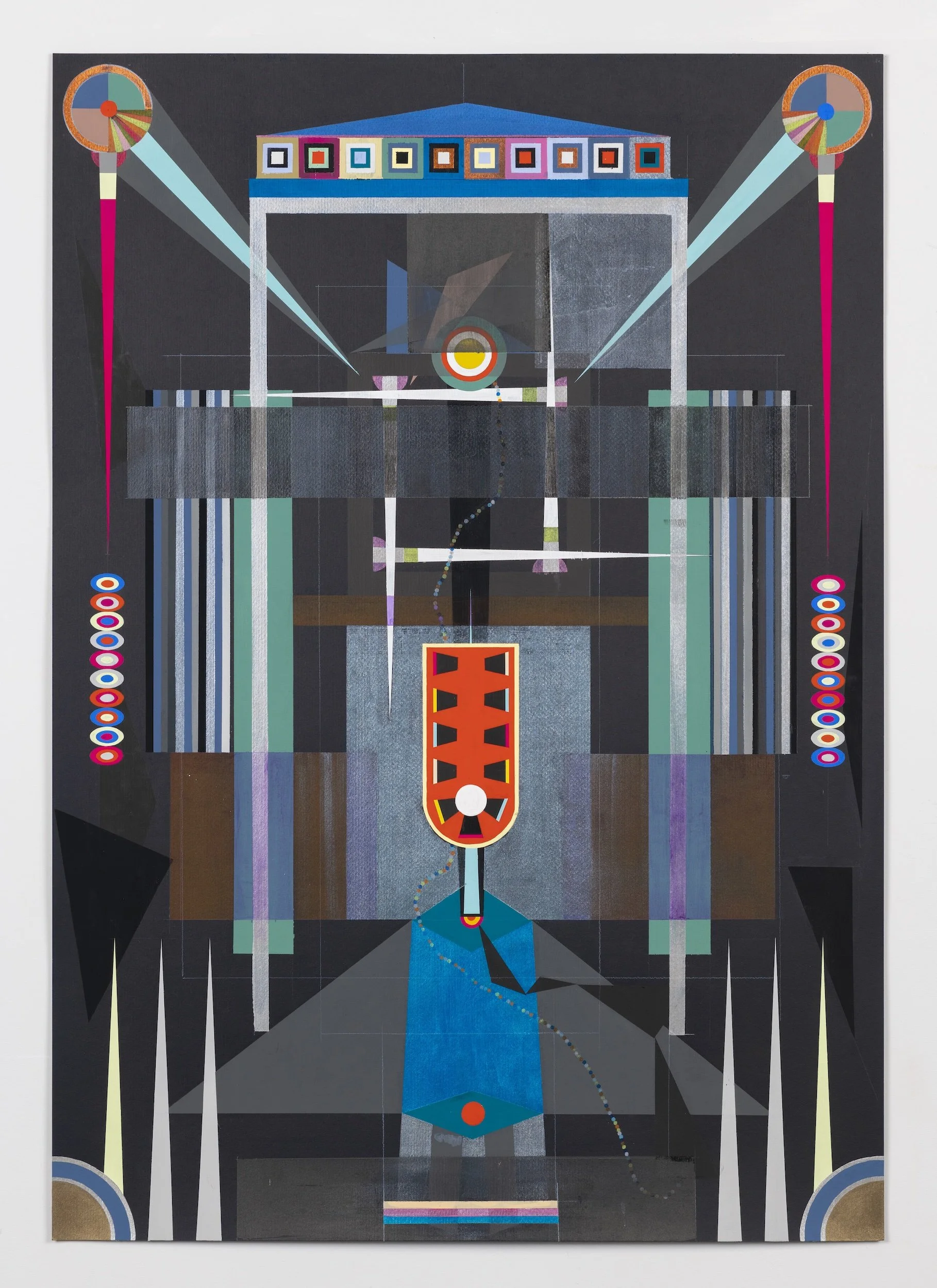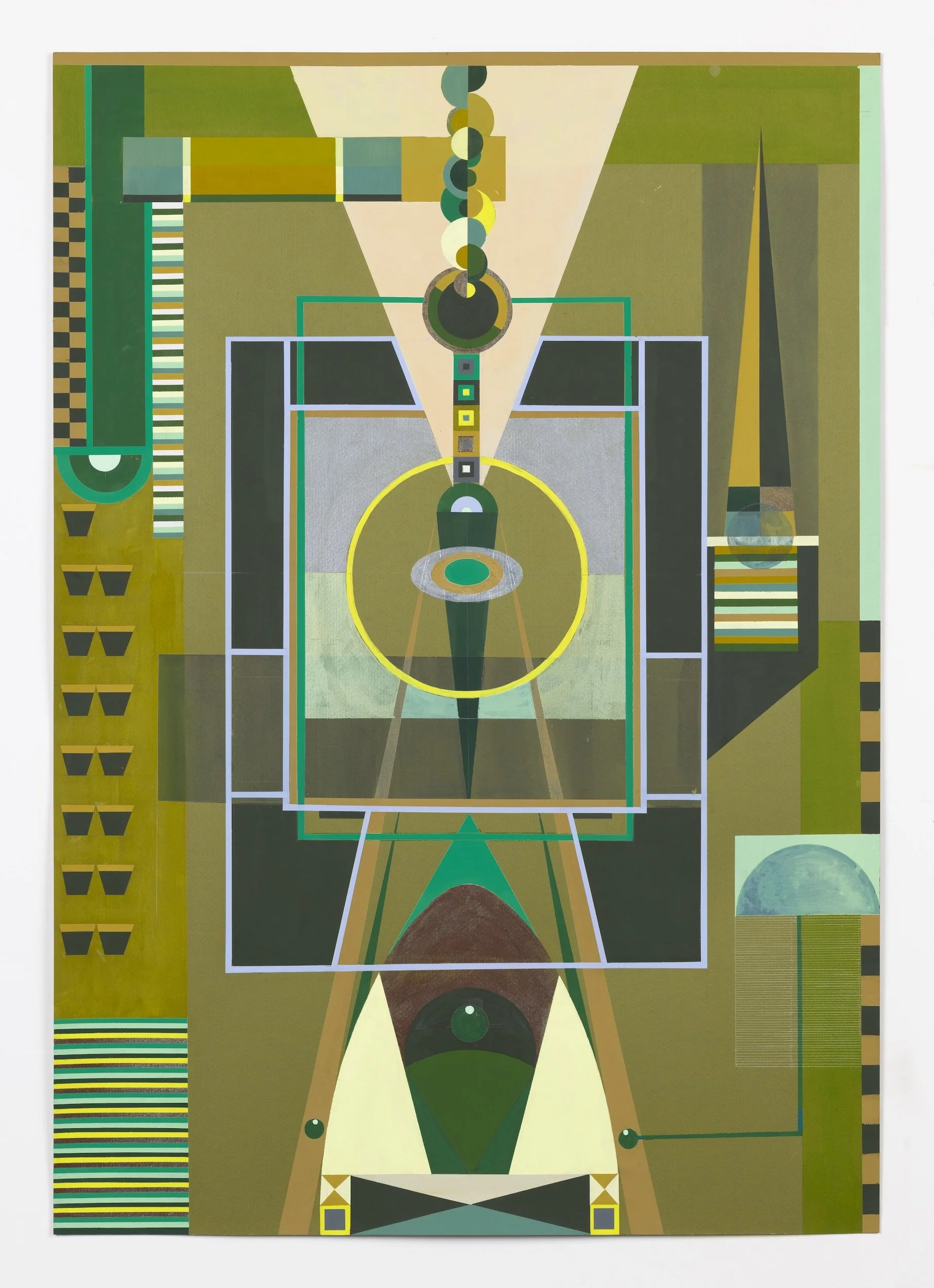Hilma’s Ghost
"You got away with it, you really have it all now. Don’t hesitate, this is your happily ever after,” 2022. Gouache, watercolor, ink, and colored pencil on Fabriano Murillo paper. 39 x 27 inches.
BIO
Hilma’s Ghost, a feminist artist collective, was co-founded by Brooklyn-based artists Dannielle Tegeder and Sharmistha Ray two years ago during the height of the pandemic in 2020. The collective seeks to address existing art historical gaps by cultivating a global network of women, nonbinary, and trans practitioners whose work addresses abstraction and mysticism. Their namesake Hilma af Klint’s groundbreaking exhibition at the Guggenheim in 2018 served as a reckoning for art history’s blindspots, especially for women artists considered too ‘mystical’ for the conservative art world. Hilma’s Ghost believes that western heteropatriarchal societies’ false binary between spirituality and science has served to overlook womxn artists whose explorations of ancient and pre-modern knowledge systems is a source of personal strength and aesthetic innovation. Hilma’s Ghost acts as a restorative project that uplifts these voices and makes them visible.
Since its inception, Hilma’s Ghost has run a dozen online programs and free public workshops and also provides a platform on their Instagram page for womxn, trans, and nonbinary artists working with spirituality through short profiles. Their online and in person programs have explored subjects ranging from shamanism, automatic drawing, to sigil making and have attracted 6K individuals including artists and spiritual practitioners from across the globe. In 2021, Hilma’s Ghost collaborated artistically on "ABSTRACT FUTURES TAROT." Exhibited at The Armory Show, the project consisted of 5 paintings, 78 drawings, and an original limited edition tarot deck. In 2022, the duo curated Cosmic Geometries, a group exhibition of 25 artists at EFA Project Space, which Jillian Steinhauer of The New York Times called “a knockout exhibition.” Their projects have been positively reviewed in The New York Times, Hyperallergic, and Artnet.
ARTIST STATEMENT
Hilma’s Ghost, a feminist artist collective, was co-founded by Brooklyn-based artists Dannielle Tegeder (she/her) and Sharmistha Ray (they/them) two years ago during the height of the pandemic. The collective acts as a restorative project that uplifts the voices of women, trans, and nonbinary artists using abstraction and mysticism in their work and makes them visible. We make art collaboratively using divinatory methods, run free programs and workshops with spiritualists for our community, and conduct research on women artists and spiritualist practices that we use in our projects and workshops. To date, we have worked together continuously, made 3 bodies of work together, and run 12+ online programs that have engaged 6K individuals worldwide. For "Radical Spirits," our upcoming solo project at the Hill-stead Museum in June 2022, we adapted the lost art of theorem painting, a women’s craft in the 19th century, to create a new body of work. Through art and public engagement, our collective seeks to identify the ways in which art and spirituality intersect to create both new liberatory practices to counter the oppressive structures of society.
Interview with Hilma’s Ghost
“Before you rush ahead, consider your options carefully. This is your time so choose wisely. Is this real or is it a fantasy? Even if it feels too good to be true at times, this next step promises an adventure. Surrender to the moment offering a new perspective,” 2022. Gouache, watercolor, ink, and colored pencil on Fabriano Murillo paper. 39 x 27 inches.
Can you tell us a bit about your background and how you became interested in becoming an artist? Who or what were some of your most important early influences?
Hilma’s Ghost is a feminist artist collective that was co-founded by Brooklyn-based artists and educators, Sharmistha Ray and Dannielle Tegeder that works at the intersections of art and mysticism. We make work together, run free online workshops, curate shows, and build community with women, nonbinary, and trans artists working at these intersections. We take inspiration from Hilma af Klint, an artist and mystic, who was overlooked in her time. It led us to question how many other women have been excluded from the cultural conversation. We already know that art is a powerful catalyst. Our first artistic collaboration was to create an original tarot deck, which has disseminated widely in our community.
Any stories you can share about early memories of how an aspect of the arts impacted you?
We have both been impacted by different schools of abstraction. Dannielle looks at Constructivism and The Bauhaus and artists like El Lissitzky. Her father was a steam-fitter, so she’s influenced by different kinds of blueprints. Having lived in different parts of the world, including India and Kuwait, Sharmistha’s influences range from the esoterism of Tantric abstraction and the pattern-making of South Asian textiles to illuminated manuscripts and Arabic calligraphy.
Where are you currently based and what initially brought you there? Are there any aspects of this specific location or community that have inspired your work?
We are both Brooklyn-based artists. We also teach in the city, so besides the incredible community of artists and the art that’s available on our doorstep, we earn our livelihoods here. Dannielle is a professor at The City University of New York at Lehman College and Sharmistha teaches at Parsons School of Design. We wouldn’t be anywhere else. The level of engagement we get in New York has spoiled us.
Can you describe your studio space? What are some of the most crucial aspects of a studio that make it functional? Do any of these specific aspects directly affect your work?
Up until this summer, we had a joint studio in which we were pretty prolific. We made 3 bodies of work consisting mainly of paintings and drawings that were shown in New York, Chicago, and Connecticut. We both need a lot of wall space because of the nature of the work we do. We don’t like clutter and like for our materials to be organized daily, so we come into the studio ready to work. The day for us both starts with a few cups of coffee! It’s an important ritual as it’s when we discuss our plan for the day and work out any issues. Being collaborators, there’s lots of collective decision-making involved, so we have to make sure we are on the same page most of the time.
“The fantasy is over, this is your reality check: you faked it until you made it so you know what this costs, but do you recognize your value?” 2022. Gouache, watercolor, ink, and colored pencil on Fabriano Murillo paper. 39 x 27 inches.
What is a typical day like? If you don't have a typical day, what is an ideal day?
There’s nothing really that typical when you’re working collaboratively, but generally, the day starts with coffee and general planning, and then we get to work, which usually involves painting, managing assistants, sending emails, and putting out a small fire or two, hypothetically speaking! An ideal day is when we can just paint for 8 hours straight, only breaking for lunch. Currently, we are working on more conceptual works like video, animation, and artist books that don’t require studio space.
What gets you in a creative groove or flow? Are snacks involved? ☺
We use our tarot deck and have adapted it in many ways to help us as creatives. It’s not only about the card or cards you draw, it’s also about staying open to the messages you receive through the cards. The cards won’t always tell you what you want to hear, but they are always truthful. Any tarot reader will tell you that the cards are not oracular. They only act as guides. We still have our agency to choose what we want to do. Because of that, the tarot lends itself so easily to our creative practice. We draw one to three cards a day before we start working and interpret the meanings. It gets our creative juices flowing!
Is there anything that interrupts and stagnates your creative energy?
The reality is we are two individuals with strong opinions, so disagreements are inevitable. Luckily, we have the tarot to break a stalemate! We always listen to the tarot and what it has to tell us. Taking a walk midafternoon, so long as the weather is favorable, also helps.
How do you select materials? How long have you worked with this particular media or method? Can you walk us through your overall process? How long has this approach been a part of your practice?
We are both painters, but as a collective we respond to the specific needs of a project. While researching for our solo exhibition, Radical Spirits, currently up at the Hill-Stead Museum in Connecticut, we came upon a small theorem painting tucked away in a drawer at the historic house on the estate. Theorem painting is a popular 19th century craft that was considered ‘women’s work.’ It involves a staining technique with oil paint on velvet, which is something we have never done but we decided to incorporate it into our work. It involved tracking down one of the few living master theorem painters and taking private lessons from her at her home in Lancaster, Pennsylvania. The result was the Automatic Theorem Paintings, which are on view in the show.
An important part of our process with all our work is ritual activation and spell creation. For this, we also work closely with the witch, Sarah Potter.
“Have you noticed that what you are looking for is already right in front of you?” 2022. Gouache, watercolor, ink, and colored pencil on Fabriano Murillo paper. 39 x 27 inches.
Can you talk about some of the ongoing interests, imagery, and concepts that have informed your process and body of work over time? How do you anticipate your work progressing in the future?
We are particularly interested in archival images of occultism, witchcraft, and tarot. We both collect tarot decks as well and have at least a dozen between us. Of course, we love the Rider-Waite deck created by Pamela Colman Smith, but also lesser known ones by Leonara Carrington and Ithell Colquhoun. Both were compelling women artists who, like Smith, were overlooked in their time.
Do you pursue any collaborations, projects, or careers in addition to your studio practice? If so, can you tell us more about those projects, and are there connections between your studio practice and these endeavors?
We are both independent artists as well as educators with academic careers. Sharmistha is also a writer. They do most of the writing for the Hilma’s Ghost project, while Dannielle mostly handles the public-facing aspects of the collective. It’s serendipitous that we have complementary skill sets.
Have you had any epiphanies recently that have changed the course of your work or caused you to shift directions?
We have both made work independently and collaboratively with other artists over the past decade. We have also both hosted salons bringing individuals - artists, poets, musicians, scientists, and people from a wide array of disciplines - together to have conversations. Our main purpose has been to connect artists with new ideas and audiences. Our energies must have fused during the pandemic to create Hilma’s Ghost. We wanted to create a community and, in the process, we started collaboratively making work. No one teaches painters to collaborate. We are trained to be solitary and territorial. As collaborators, each new body of work we make together is unlike anything we could imagine making by ourselves. There are epiphanies along the way when you collaborate with someone else. You have to be open to the unexpected, even more than when you work by yourself.
“When you are stuck in the past and clinging to your old ways, you will miss out on the open road ahead of you. This cycle ends now. You aren’t alone in this one because we are all in this boat together. What are you waiting for? The only way out is through,” 2022. Gouache, watercolor, ink, and colored pencil on Fabriano Murillo paper. 39 x 27 inches.
As a result of the pandemic, many artists have experienced limited access to their studios or loss of exhibitions, income, or other opportunities. Has your way of working (or not working) shifted significantly during this time? Are there unexpected insights or particular challenges you’ve experienced?
The pandemic caused so much isolation and suffering. Hilma’s Ghost was actually born during this time. From the beginning, we wanted to create a cultural platform to bring marginalized voices together and heal as a community. So far, we have run over a dozen free online workshops that have reached thousands of individuals. We didn’t expect to actually work together as artists. That has been an accidental (and fortunate) outcome of this collective. Unbeknownst to us, Dannielle’s Chicago gallerist, Carrie Secrist, loved what we were doing and applied to The Armory Show with a solo booth for Hilma’s Ghost. It’s the first time we collaborated as artists. The rest feels like history.
Can you share some of your recent influences? Are there specific works—from visual art, literature, film, or music—that are important to you?
We both loved Beyond the Visible, the film about Hilma af Klint by Halina Dryschka. It boggles the mind how brilliant women were left out of the canon just by the virtue of being women. We also recommend the books Thought Forms by Annie Besant and C.W. Leadbetter and Tantra Song by Franck André Jamme for abstract painters out there.
Who are some contemporary artists you’re excited about? What are the best exhibitions you’ve seen in recent memory and why do they stand out?
There are so many artists we admire like Louise Despont, Edie Fake, Caroline Kent, Johanna Unzueta, Yevgeniya Baras, and Kaveri Raina to name a few contemporary abstract painters. Our collective also curated an exhibition of 25 intergenerational artists called Cosmic Geometries at EFA Project Space in New York earlier this year. It was a diverse group of mostly women, nonbinary, and trans artists working with abstraction and esoterism. We used divinatory methods to install that show, which inspired a mixture of trepidation and excitement! The catalogue for that exhibition was just published and is available at EFA Project Space.
“Once you recognize the reality, the right decision is easy. After all, you can’t take it with you and money is best shared and enjoyed with people you love so go ahead and host that party in honor of everything you finally let go of from your past. Imagine if you just put yourself first now because who said self care is merely a daydream? This is a fantasy to get swept up in,” 2022. Gouache, watercolor, ink, and colored pencil on Fabriano Murillo paper. 39 x 27 inches.
Do you have any tips or advice that someone has shared with you that you have found particularly helpful?
Making an enemy of envy is a good one. It’s so easy to look at what others are getting and get yourself down. Find ways to be generous to other artists and continue working.
What are you working on in the studio right now? What’s coming up next for you?
We have a solo exhibition called Radical Spirits up at the Hill-Stead Museum in Farmington, CT until November 1. That show brings together three different bodies of our work that addresses tarot, automatism, and feminist histories. We are visiting artists in residence at the Wassaic Project and have a solo exhibition upcoming at Carrie Secrist Gallery in Chicago, where we will also curate the second iteration of Cosmic Geometries with women, nonbinary, and trans artists living in the Midwest.
Anything else you would like to share?
If you’re interested in checking out our past programs on topics ranging from shamanism, to witchcraft, and tarot, go to our website hilmasghost.com where we make all this available for free. We also announce our free workshops, do magic rituals, and profile interesting artists working with the occult on Instagram @hilmasghost.






